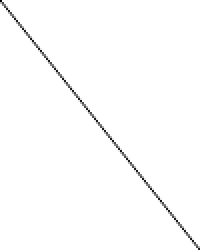This file contains Unicode characters that might be confused with other characters. If you think that this is intentional, you can safely ignore this warning. Use the Escape button to reveal them.
Interpolation techniques
This article will cover a few of the standard techniques for temporal video frame interpolation, outlining in particular the difference between techniques like SVP/MVtools (also known as motion-based interpolation) and algorithms like smoothmotion. You can also find a set of test clips specifically designed to replicate the results of these algorithms, alongside some more explanation, in this repository.

To demonstrate the differences, we will look at what happens when trying to display a 24 Hz video file on 60 Hz monitor. This is the source file I will be using. For illustration, each video frame will appear as one horizontal line of the image. (So the vertical axis is the time axis)
We will now discuss different techniques of converting this to a 60 Hz video stream (suitable for display on a 60 Hz monitor, for example). As a result, the vertical axis will be rescaled from 100 pixels to 250 pixels. (60/24 = 2.5)
3:2 pulldown

The traditional technique, including the default mpv behavior, is to simply hold each source frame until the corresponding timestamp of the next frame has passed. Due to the particular ratio in this example (60/24 = 2.5), it means that the first frame will be shown 3 times, the second frame 2 times, the third 3 times, the fourth 2 times and so on. The pattern looks like this:
A A A B B C C C D D E E E F F
As can be clearly seen, the inconsistent width results in a jagged appearance, which is a visualization of the phenomenon known as judder.
This technique is essentially like nearest neighbour upscaling - each frame simply picks the source frame that's closest to it in the original video source (rounded down).
Motion-based interpolation

Motion-based interpolation algorithms like SVP, MVTools or the chips built into various TV devices employ complex algorithms to try and recognize movement in the video (motion vectors), and fill in the missing gaps as needed.
This drastically alters the result - it's now one continuous motion, similar to a true 60 Hz clip. However, this comes at a cost - not only are the mathematics involved extremely expensive to compute, but the algorithms also aren't perfect, and often result in artifacts (deformed images, wavy lines, etc.).
Furthermore, this is the source of the so-called soap opera effect, which is simply referring to what 60 Hz motion looks like. The name is based on the fact that cheap TV programs like soap operas are often filmed at interlaced 60 Hz rather than the (more expensive) film format that most cinematic content uses, which is usually shot at 24 Hz. Many people therefore subconsciously associate the visual appearance of 60 Hz content with soap operas, and thus think it looks worse.
This is essentially similar to "smart" upscaling filters, eg. NEDI or NNEDI3 - which are also expensive to compute and produce results that drastically alter the source image.
Smoothmotion

The smoothmotion approach is to display each frame exactly 2.5 times, where we display frames for 0.5 times by blending two adjacent frames together. In terms of the pattern, it results in something like this:
A A A+B B B C C C+D D D E E E+F F F
Here, A+B refers to a frame that is exactly half of A and half of B, blended together. The overall result is that each frame is displayed for a consistent amount of time, resulting in smooth motion.
As you can see, the overall appearance is smoother due to the increased regularity of the frame heights, and the overall perceived framerate (24 Hz) has not been affected - the lines are still clearly distinct.
This is not only easy to calculate (no motion-based prediction whatsoever, just a simple blending operation of two frames), but also preserves the perceived framerate of the original clip, so there's no soap opera effect or similar.
Essentially, smoothmotion is like using a nearest neighbour resize but oversampling the result (similar to how multi-sampling works in video games to reduce aliasing). Due to this, it's called "oversample" in the mpv implementation.
Convolution-based interpolation

This mode of operation is based on the idea to treat the time dimension of a video clip as just another static dimension, the same as the resolution - essentially, we are treating the input as a big 3D signal of size Width×Height×Duration, reconstructing this input using standard techniques from signal theory. Basically, instead of convolving the kernel with discrete pixels in the source image, we convolve the kernel with the same pixels across discrete frames.
The main difference to smoothmotion is that it essentially low-passes the time axis to make sure no high frequency distortions get added (which can look like irregularities with the smoothmotion algorithm), and that it can reconstruct some “intermediate” pixel values, which works well for slow motion in particular, but can add extra motion blur in some cases.
As you can see, the overall appearance looks similar to smoothmotion, but instead of frame transitions alternating between sharp and blended, each frame is always blended into the next one.
There is also a theoretically plausible mode of operation known as "Sphinx", which is based on interpolating all three dimensions at the same time using a carefully constructed filter that has a perfectly spherical frequency response, which is speculated to be better at preserving frequencies on diagonal lines (eg. static images in motion). The naming is based on a continuation of Sinc and Jinc, with Sphinx standing for sphere as the 3D analog of the others, which are for 1D and 2D, respectively. While available in 7d10c9b76f for the curious, it won't make it into master as it's excessively slow and offers no visible benefit, while also ringing too strongly at radius 3 or above. (If anything, it would have to be used with some sort of temporal antiringing)